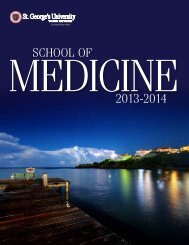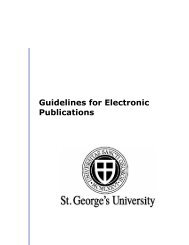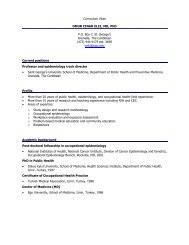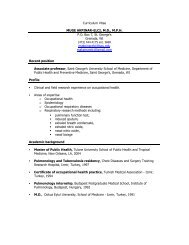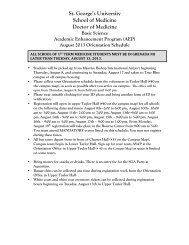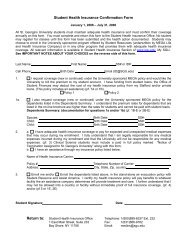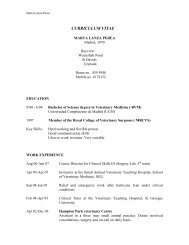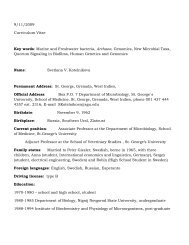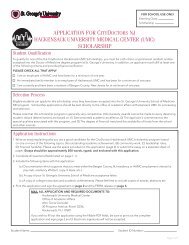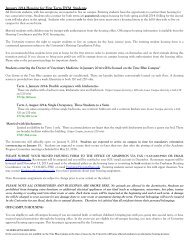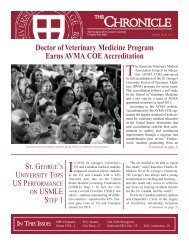SVM Catalogue 2012-2013 - St. George's University
SVM Catalogue 2012-2013 - St. George's University
SVM Catalogue 2012-2013 - St. George's University
You also want an ePaper? Increase the reach of your titles
YUMPU automatically turns print PDFs into web optimized ePapers that Google loves.
PTHB 505<br />
Veterinary Parasitology<br />
(4 cr.) (Didactic 3 cr./Laboratory 1 cr.) The course consists<br />
of lectures and laboratory classes covering the helminthes,<br />
anthropods, and protozoa occurring as important parasites<br />
of domestic and wildlife species. A taxonomic approach<br />
is taken, but emphasis is placed on practical aspects such<br />
as the parasites’ developmental cycles, clinical features,<br />
pathogenesis of disease, immunology, epidemiology,<br />
public health aspects, laboratory and clinical diagnosis,<br />
treatment, and control. Particular attention is paid to<br />
providing a host approach so that the parasites and their<br />
hosts are placed in context.<br />
PTHB 506<br />
Veterinary Pathology I<br />
(5 cr.) (Didactic 4 cr./Laboratory 1 cr.) The course includes<br />
general pathology and systemic pathology. The general<br />
principles and mechanisms of disease are discussed<br />
through the basic principles of cell and tissue reactions<br />
to injury, including degeneration, necrosis, pathological<br />
pigmentation, disturbances of circulation, disturbances of<br />
growth, neoplasia, inflammation, and immunopathology.<br />
PTHB 515<br />
Veterinary Virology<br />
(3 cr.) (Didactic) The content of the course includes a<br />
general consideration of the unique biological features<br />
of viruses in terms of their reproduction as well as special<br />
points of relevance concerning their diagnosis and therapy.<br />
Viruses of particular importance in veterinary medicine<br />
are studied, including their therapy, epidemiology,<br />
pathogenesis, and laboratory diagnoses.<br />
PTHB 532<br />
Clinical Pathology<br />
(4 cr.) (Didactic 3 cr./Laboratory 1 cr.) <strong>St</strong>udents gain an<br />
understanding of the principles of hematology, cytology,<br />
and clinical chemistry in the course. Instruction in<br />
interpretation of alterations in peripheral blood smears,<br />
cytological samples from various organ systems, and<br />
chemical data derived from blood serum or other body<br />
fluids is provided. Extensive use is made of clinical cases to<br />
emphasize correct interpretation of reports.<br />
Year 2: Term 4 Required Courses<br />
LAMS 503<br />
Introduction to Clinical Medicine<br />
(4 cr.) (Didactic) This course is designed to introduce<br />
fourth-term students to the practice of clinical medicine.<br />
It is a team-taught course where presenting complaints,<br />
history, clinical signs, physical examination, and specific<br />
diagnostic testing is used to design problem lists, differential<br />
diagnoses, and introduce veterinary methods for case<br />
workup. Individual student assignments utilize practical case<br />
evaluation and use of current research via electronic journals<br />
for support of case evaluation. This course provides the<br />
foundation to the third-year courses that specifically cover<br />
small animal, equine, and food animal medicine.<br />
PTHB 507<br />
Veterinary Pathology II<br />
(5 cr.) (Didactic 4 cr./Laboratory 1 cr.) This course completes<br />
the systemic pathology of domestic animals with emphasis<br />
on the etiology, pathogenesis, gross and microscopic<br />
lesions, and diagnosis of diseases of the organ systems in<br />
the body. Formal classroom lectures are complemented<br />
with laboratory classes and necropsy demonstrations<br />
aimed at interpretation of gross and microscopic lesions.<br />
PTHB 510<br />
Veterinary Public Health<br />
(2 cr.) (Didactic) The role of the veterinarian in public health<br />
is considered with emphasis on the safety of foods of<br />
animal origin. The course includes the responsibilities of<br />
the veterinarian in the prevention and control of zoonotic<br />
diseases and surveys zoonotic diseases of bacterial and viral<br />
origins with special attention to emerging infectious diseases.<br />
PTHB 511<br />
Veterinary Epidemiology<br />
(1 cr.) (Didactic) The course provides students with an<br />
understanding of the basic concepts of veterinary<br />
epidemiology and includes practical exercises on the<br />
strengths and weaknesses of different epidemiological<br />
study designs. The quality of evidence of causal<br />
relationships provided by different epidemiological study<br />
designs is compared and discussed within the framework<br />
of evidence-based medicine in order to judge the benefits<br />
of treatment and/or prevention and control methods.<br />
The course includes the application of epidemiological<br />
principles and the veterinarian’s role in the investigation of<br />
outbreaks in animal and human populations.<br />
School of Medicine<br />
Course Descriptions<br />
School of Veterinary Medicine Catalog <strong>2013</strong>–2014 | 51



